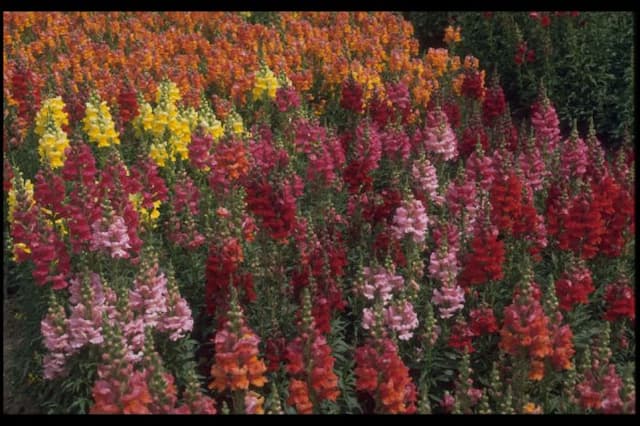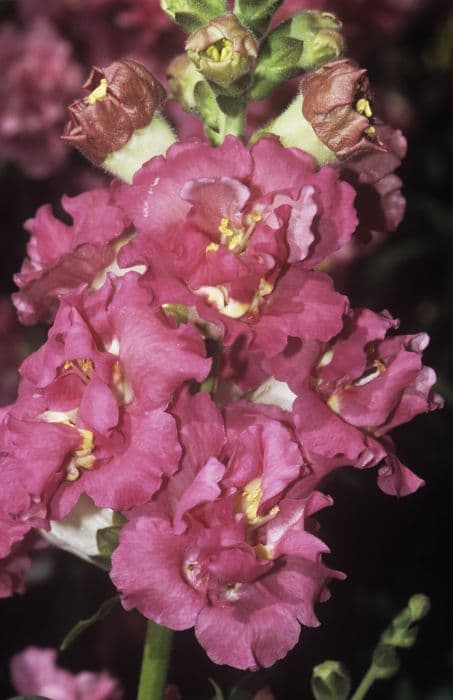Beardtongue Penstemon 'Hidcote Pink'

ABOUT
Penstemon 'Hidcote Pink', also known as beardtongue, is a flowering perennial that is notable for its striking blooms. The flowers are a soft, rosy pink hue, with a bell-shaped and tubular form that is appealing to pollinators such as hummingbirds and bees. The blooms are neatly arranged on tall spikes that rise above the foliage and create a lovely vertical element in the garden. The leaves of the Hidcote Pink beardtongue are narrow and lance-shaped, with a somewhat glossy finish and a rich green color. These leaves can vary in size and are typically arranged oppositely along the stems, providing an attractive backdrop for the delicate flowers. This particular variety of Penstemon is praised for its long flowering period, often providing color from late spring into the summer months. The overall impression of the 'Hidcote Pink' is one of delicate beauty and soft color, with its pink blossoms standing out against the verdant foliage, making it a cherished addition to ornamental borders and beds.
About this plant
 Names
NamesFamily
Plantaginaceae
Synonyms
Beard Tongue, Beardtongue
Common names
Penstemon 'Hidcote Pink'.
 Toxicity
ToxicityTo humans
Penstemon 'Hidcote Pink', commonly known as Beardtongue, is not known to be toxic to humans. There are no common reports of poisoning or adverse reactions from ingesting or handling this plant. However, it is generally advisable not to consume any part of ornamental plants due to potential individual allergies or unknown reactions.
To pets
Beardtongue is also not known to be toxic to pets. It is not listed among the commonly recognized poisonous plants for animals such as cats and dogs. As with humans, pets are unlikely to experience symptoms of poisoning from ingesting this plant. However, it is always best to prevent pets from chewing on non-food plants to avoid any potential gastrointestinal upset or unforeseen allergic reactions.
 Characteristics
CharacteristicsLife cycle
Perennials
Foliage type
Semi-deciduous
Color of leaves
Green
Flower color
Pink
Height
2 feet (60 cm)
Spread
2 feet (60 cm)
Plant type
Herb
Hardiness zones
3
Native area
North America
Benefits
 General Benefits
General Benefits- Attracts Pollinators: Penstemon 'Hidcote Pink' is known to attract bees, butterflies, and hummingbirds, which are essential for the pollination of plants.
- Low Maintenance: It is a hardy plant that does not require frequent care or watering once established, making it ideal for low-maintenance gardens.
- Drought Tolerance: Once established, Penstemon has good drought tolerance, which makes it suitable for xeriscaping or gardens in arid climates.
- Long Blooming Period: Penstemon 'Hidcote Pink' has a lengthy blooming season from late spring to early fall, providing long-lasting color in the garden.
- Aesthetic Appeal: The plant offers a visually striking appearance with its bright pink tubular flowers and can complement a variety of garden designs.
- Erosion Control: The fibrous root system of Penstemon can help stabilize soil and control erosion on slopes or in areas with loose soil.
- Cold Hardy: Penstemon 'Hidcote Pink' can withstand cold temperatures, making it a good choice for gardens in cooler climates.
- Versatility in Landscaping: Penstemon can be used in a variety of garden settings, including borders, rock gardens, and cottage gardens.
- Non-Invasive: Unlike some ornamental plants, Penstemon generally does not become invasive and is easier to manage in the garden.
- Deer Resistance: Penstemon is considered deer resistant, which is beneficial in areas where deer browse on garden plants.
 Medical Properties
Medical PropertiesThis plant is not used for medical purposes.
 Air-purifying Qualities
Air-purifying QualitiesThis plant is not specifically known for air purifying qualities.
 Other Uses
Other Uses- Penstemon flowers can be used as a natural dye for fabrics, giving them a soft, pink hue when treated properly.
- The cut flowers of the Penstemon can serve as an eco-friendly alternative to traditional dyes in art projects, such as coloring paper or in botanical prints.
- Because of their nectar-rich blooms, Penstemon can be planted to support local butterfly and insect populations, contributing to biodiversity and ecosystem health.
- Dried Penstemon flowers can be incorporated into homemade potpourri mixes for a subtle fragrance and splash of color in your home decor.
- Penstemon plants can be used in xeriscaping, a landscaping technique that reduces the need for irrigation, making it an environmentally friendly garden choice.
- These flowers can also be used in edible landscaping; while not typical, some Penstemons have edible parts that can add color and mild flavor to salads (always verify edibility with a reliable source).
- Penstemon's vertical growth habit makes them ideal for adding structure and height in floral arrangements and bouquets.
- The sturdy stems of Penstemon can be used in crafts, like making natural wreaths or as supports for other plants in horticultural displays.
- The flowers can be used for educational purposes, such as teaching botany and pollination strategies in school gardens or community workshops.
- Penstemon can be included in a "bee lawn" or pollinator garden, where their specific flowering time helps provide a season-long food source for bees and other pollinators.
Interesting Facts
 Feng Shui
Feng ShuiThe Beardtongue is not used in Feng Shui practice.
 Zodiac Sign Compitability
Zodiac Sign CompitabilityThe Beardtongue is not used in astrology practice.
 Plant Symbolism
Plant Symbolism- Strength - Penstemon often symbolizes strength due to its sturdy nature and ability to withstand harsh conditions.
- Endurance - This plant is known for its long blooming season, representing the ability to persist and endure over time.
- Health - With its medicinal properties used by Native Americans, Penstemon can symbolize good health and healing.
- Beauty - 'Hidcote Pink', with its attractive pink blossoms, signifies beauty and admiration.
- Diversity - As part of a genus with a wide range of varieties, it can represent the beauty of diversity and variation.
 Water
WaterBeardtongues, such as Penstemon 'Hidcote Pink', prefer well-draining soil and should be watered once the top inch of soil feels dry to the touch. This typically amounts to 1 inch of water per week, which can be adjusted depending on rainfall, humidity, and temperature. Use soaker hoses or drip irrigation to deliver water directly to the roots, avoiding overhead watering to prevent fungal diseases. During the growing season, a generous watering once a week is usually sufficient, while in winter, reduce watering frequency as the plant's water requirements decrease.
 Light
LightBeardtongues thrive in a location where they receive full sun for at least six to eight hours a day. Penstemon 'Hidcote Pink' will perform best and produce the most blooms when placed in an area with unobstructed sunlight. However, in extremely hot climates, providing light afternoon shade can help protect the plant from scorching.
 Temperature
TemperatureThe beardtongue prefers moderate temperatures and can generally tolerate conditions between 60°F and 80°F. Penstemon 'Hidcote Pink' is hardy and can withstand temperatures as low as 10°F in winter and as high as 90°F in summer. Ideal growing conditions are within this temperature range, ensuring the plant remains healthy and capable of blooming.
 Pruning
PruningPruning Penstemon 'Hidcote Pink' is important for maintaining plant shape and encouraging more robust flowering. Prune in early spring to remove any dead or damaged stems and again after the first flush of blooms to encourage a second round of flowering. The best time for significant pruning is late winter or early spring before new growth starts.
 Cleaning
CleaningAs needed
 Soil
SoilBeardtongue 'Hidcote Pink' thrives in well-draining soil with a slight preference for alkaline conditions; a pH range of 6.0 to 8.0 is ideal. A soil mix containing loamy garden soil, compost, and a bit of sand or perlite for improved drainage would suit this plant well. Regular garden soil can be improved with organic matter; avoid overly wet or poorly drained soils.
 Repotting
RepottingBeardtongue 'Hidcote Pink' does not require frequent repotting and can be repotted every 2-3 years or as necessary if it outgrows its pot or the soil seems depleted. Repotting should be done in spring before new growth begins for optimal plant health.
 Humidity & Misting
Humidity & MistingBeardtongue 'Hidcote Pink' is quite tolerant of varied humidity levels and does best in average outdoor conditions. It doesn't require high humidity; normal ambient outdoor humidity suits this plant well.
 Suitable locations
Suitable locationsIndoor
Place in bright light, well-draining soil; avoid overwatering.
Outdoor
Full sun to partial shade, well-drained soil, average water.
Hardiness zone
4-9 USDA
 Life cycle
Life cyclePenstemon 'Hidcote Pink', also known as Beardtongue, begins its life cycle when seeds are dispersed into suitably well-draining soil in late spring or early summer. Germination follows, typically taking a few weeks, and young seedlings emerge with their first true leaves. As they grow, they develop into a rosette of foliage, and by the second year, they form upright stems that begin to display the characteristic tubular pink flowers which attract bees and hummingbirds. After flowering, usually from late spring to early summer, the plant sets seed, which can be left to self-sow or collected for propagation. Throughout the growing season, the foliage remains a lush green, sometimes with a hint of purple, dying back in the winter. This perennial often lives for several years but will require division every 3-5 years to maintain vigor.
 Propogation
PropogationPropogation time
Spring to early summer
Propogation: The most popular method of propagation for Penstemon 'Hidcote Pink', often referred to as Beardtongue, is through softwood cuttings. The ideal time to take these cuttings is in late spring to early summer, when the plant's growth is vigorous and the stems are not yet woody. To propagate, a gardener would cut a 3 to 5-inch (about 7.5 to 12.5 cm) section from the tip of a healthy stem, removing the lower leaves to expose the nodes where roots can form. This cutting is then dipped in a rooting hormone and placed in a moist potting mix. The cutting should be kept in a warm, well-lit area but out of direct sunlight, ensuring that the soil remains consistently moist but not waterlogged. Roots typically develop within a few weeks, after which the new plant can be gradually hardened off before transplanting outdoors.





![Snapdragon [Pretty in Pink]](/_next/image?url=https%3A%2F%2Fplants-admin.emdemapps.com%2Fimages%2Fplants%2F%2Fimages%2F604b5cb3b5385.png&w=640&q=75)



